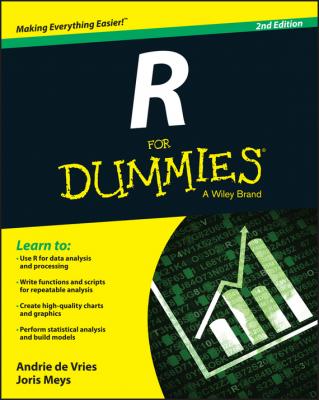R For Dummies. Vries Andrie de
Читать онлайн.| Название | R For Dummies |
|---|---|
| Автор произведения | Vries Andrie de |
| Жанр | Зарубежная образовательная литература |
| Серия | |
| Издательство | Зарубежная образовательная литература |
| Год выпуска | 0 |
| isbn | 9781119055839 |
Beyond the Book
R For Dummies includes the following goodies online for easy download:
✔ Cheat Sheet: You can find the Cheat Sheet for this book here:
✔ Extras: We provide a few extra articles here:
✔ Example code: We provide the example code for the book here:
If we have updates to the content of the book, look here for it:
Where to Go from Here
There’s only one way to learn R: Use it! In this book, we try to make you familiar with the usage of R, but you’ll have to sit down at your PC and start playing around with it yourself. Crack the book open so the pages don’t flip by themselves, and start hitting the keyboard!
Part I
Getting Started with R Programming
✔ Introducing R programming concepts.
✔ Creating your first script.
✔ Making clear, legible code.
✔ Visit www.dummies.com for great Dummies content online.
Chapter 1
Introducing R: The Big Picture
▶ Discovering the benefits of R
▶ Identifying some programming concepts that make R special
With an estimated worldwide user base of more than 2 million people, the R language has rapidly grown and extended since its origin as an academic demonstration language in the 1990s.
Some people would argue – and we think they’re right – that R is much more than a statistical programming language. It’s also
✔ A very powerful tool for all kinds of data processing and manipulation
✔ A community of programmers, users, academics, and practitioners
✔ A tool that makes all kinds of publication-quality graphics and data visualizations
✔ A collection of freely distributed add-on packages
✔ A versatile toolbox for extensive automation of your work
In this chapter, we fill you in on the benefits of R, as well as its unique features and quirks.
Tracing the history of R
Ross Ihaka and Robert Gentleman developed R as a free software environment for their teaching classes when they were colleagues at the University of Auckland in New Zealand. Because they were both familiar with S, a programming language for statistics, it seemed natural to use similar syntax in their own work. After Ihaka and Gentleman announced their software on the S-news mailing list, several people became interested and started to collaborate with them, notably Martin Mächler.
Currently, a group of 21 people has rights to modify the central archive of source code (http://www.r-project.org/contributors.html). This group is referred to as the R Core Team. In addition, many other people have contributed new code and bug fixes to the project.
Here are some milestone dates in the development of R:
✔ Early 1990s: The development of R began.
✔ August 1993: The software was announced on the S-news mailing list. Since then, a set of active R mailing lists has been created. The web page at www.r-project.org/mail.html provides descriptions of these lists and instructions for subscribing. (For more information, turn to “It provides an engaged community,” later in this chapter.)
✔ June 1995: After some persuasive arguments by Martin Mächler (among others) to make the code available as “free software,” the code was made available under the Free Software Foundation’s GNU General Public License (GPL), Version 2.
✔ Mid-1997: The initial R Development Core Team was formed (although, at the time, it was simply known as the core group).
✔ February 2000: The first version of R, version 1.0.0, was released.
✔ October 2004: Release of R version 2.0.0.
✔ April 2013: Release of R version 3.0.0.
✔ April 2015: Release of R-3.2.0 (the version used in this book).
Ross Ihaka wrote a comprehensive overview of the development of R. The web page http://cran.r-project.org/doc/html/interface98-paper/paper.html provides a fascinating history.
Recognizing the Benefits of Using R
Of the many attractive benefits of R, a few stand out: It’s actively maintained, it has good connectivity to various types of data and other systems, and it’s versatile enough to solve problems in many domains. Possibly best of all, it’s available for free, in more than one sense of the word.
R is available under an open-source license, which means that anyone can download and modify the code. This freedom is often referred to as “free as in speech.” R is also available free of charge – a second kind of freedom, sometimes referred to as “free as in beer.” In practical terms, this means that you can download and use R free of charge.
As a result of this freedom, many excellent programmers have contributed improvements and fixes to the R code. For this reason, R is very stable and reliable.
